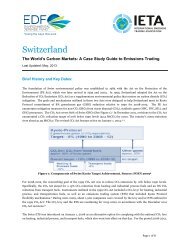Japan / The World's Carbon Markets - IETA
Japan / The World's Carbon Markets - IETA
Japan / The World's Carbon Markets - IETA
You also want an ePaper? Increase the reach of your titles
YUMPU automatically turns print PDFs into web optimized ePapers that Google loves.
While the nation-wide, mandatory ETS was abandoned in November 2012; the Basic Act on Global Warming<br />
Countermeasures introduced a carbon tax and established a feed-in tariff for all renewable energy<br />
sources. <strong>The</strong>se measures introduce new taxes on coal, oil, and natural gas, as well as a feed-in tariff that incentivizes<br />
increased domestic renewable energy generation in order to meet the 2020 clean primary energy supply target of<br />
10%. 60 For FY 2011, the tax on fossil fuels increased by JPY$ 0.76 (USD$0.0096 61 ) per liter of petrol, an amount<br />
corresponding to an annual outlay of more than JPY$ 1,000 (USD$12.61 62 ) per household. 63<br />
National Level<br />
1990s<br />
1990: Action Plan to Arrest Global Warming<br />
1998: Adoption of Kyoto Protocol in <strong>Japan</strong><br />
- Promotion of Nuclear Power<br />
- Energy Conservation Law<br />
- Law Concerning the Promotion of Measures to Cope with Global Warming<br />
2000-2005 2002: Ratification of Kyoto Protocol<br />
- Decentralized climate change planning under “Target Achievement Plan”<br />
2005: Enforcement of Kyoto Protocol<br />
- Lower levels of government plans drawn up<br />
2005-<br />
present<br />
2008: Complete revision of Target Achievement Plan<br />
- Focus shifts more towards Kyoto mechanism.<br />
2009: Prime Minister Yukio Hatoyama announces cuts of 25% from 1990 levels<br />
2012: Prime Minister Noda dissolved the Lower House and abandoned the proposed<br />
nation-wide ETS<br />
2013: Prime Minister Abe ordered the reexamination of <strong>Japan</strong>’s climate policies,<br />
including the 25% reduction target by 2020 relative to 1990 levels.<br />
Table 2: History of Action on Climate Change Mitigation in <strong>Japan</strong>. Source: PBL 2012 64<br />
CHALLENGES:<br />
1. As evidenced by the deferral of a nation-wide ETS in December 2010 and the subsequent abandonment in<br />
November 2012, concerns over ETS costs in <strong>Japan</strong> are influential.<br />
2. <strong>Japan</strong>’s climate targets are ambitious compared to those of other industrialized countries, but <strong>Japan</strong>’s refusal<br />
to renew its Kyoto commitment may indicate that political interest in climate action is waning.<br />
UNIQUE ISSUES:<br />
1. <strong>The</strong>re is splintered sentiment toward cap-and-trade in <strong>Japan</strong>. At the local level, the Tokyo government,<br />
the country’s largest sub-national governing body, implemented an ETS with absolute, mandatory targets in<br />
April 2010. At the national level, JVERS and the EI ETS have built regulatory and infrastructural capacity for<br />
emissions trading. Despite these promising ETS actions, momentum towards a mandatory, nation-wide ETS<br />
with absolute caps has stagnated since December 2010.<br />
Page 7 of 9










![South Korea [PDF] - International Emissions Trading Association](https://img.yumpu.com/38055599/1/190x245/south-korea-pdf-international-emissions-trading-association.jpg?quality=85)
